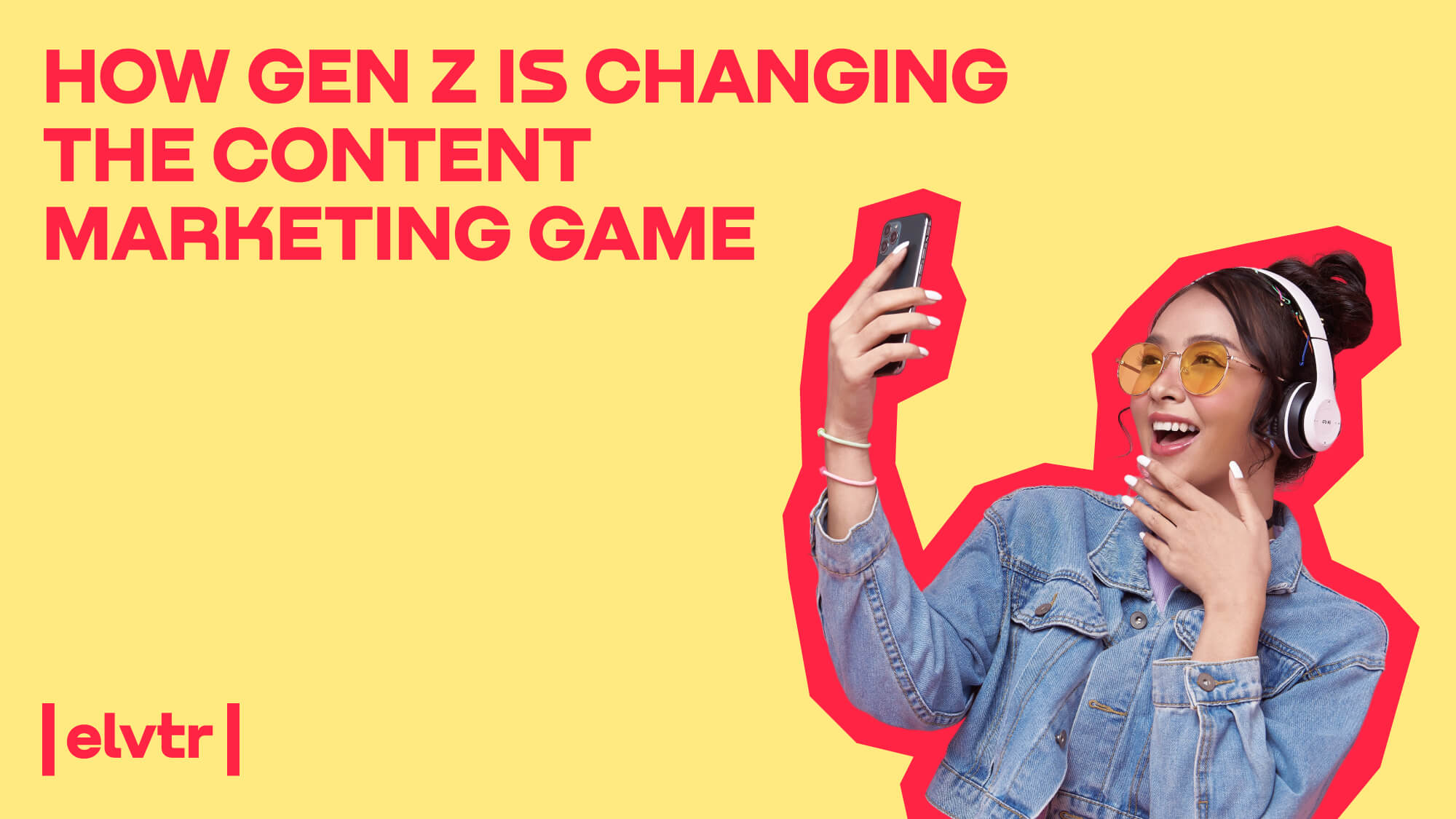- MAIN PAGE
- – elvtr magazine – How Gen Z is Changing the Content Marketing Game
How Gen Z is Changing the Content Marketing Game

Beginning in 2020, Gen Z – those born between 1997 and 2012 – has been driving up to 40% of all consumer purchases. Now, as 'Zillennials' come into their own, their influence on the economy is burgeoning, with their collective income poised to reach $33 trillion by 2031, outpacing that of millennials.
Traditional marketing and sales strategies, however, do not resonate with Gen Z consumers. Notably, they often multitask across 3-4 activities simultaneously. Furthermore, their attention is fleeting – if not engaged within the first 8 seconds, they disengage.
Let us delve into the content preferences of 'Zillennials,' how global brands are tailoring their strategies to attract Gen Z, and the emerging trends in content marketing that are forging robust connections with this demographic.
Content Marketing Trends for Tapping into Gen Z's Spending Power
Gen Z is revolutionizing technology, social causes, and much more, each with their unique traits.
'Zillennials' are virtually active 24/7, having grown up with the internet, social media, and evolving smartphones, thus shaping their distinct habits.
Their day begins with checking social media, scrolling through platforms like TikTok and Instagram, even during classes or workouts. They enjoy ASMR videos and fall asleep to Lo-Fi playlists or meditations, restarting the cycle the next day.
This unique media consumption has given rise to several trends marketers need to watch.
#1. TikTok Is Nearly At The Top Of The Social Media Game
When it comes to monthly Gen Z users, the leading social networks are Snapchat (44.5 million users), TikTok (41.4 million), and Instagram (37.3 million). Additionally, for Gen Z shoppers discovering brands, TikTok and Instagram emerge as the primary social media platforms.
A significant 78% of Gen Z individuals turn to TikTok and Instagram to find content that is either funny or entertaining. Given that 'Zillennials' are identified as the most stressed generation, it's unsurprising that they gravitate towards content that lightens the mood.
Meanwhile, TikTok has evolved beyond just dance videos to become a center for exploration of Gen Z fashion, trends, and more, signifying its burgeoning influence in the social media realm.
In meeting the challenge of capturing Gen Z's fleeting attention span, marketers are urged to innovate and engage with content that resonates, making platforms like TikTok and Instagram invaluable tools in the evolving landscape of content marketing
#2. Short Videos Are Smashing Viewing Records
In the current digital era characterized by multitasking and the fear of missing out (FOMO), social media platforms are fiercely competing for user attention, with video content leading the charge. Advertising post statistics on Facebook reveal that video content significantly outperforms photos: video reaches 57% of the platform's audience, 83% of people click on posts containing videos, and 75% of viewers convert into leads after watching a commercial.
The duration of video viewing correlates directly with increased time spent on the platform. Engaging with the content through likes or comments enhances the likelihood of the account being recommended to other users, amplifying its reach and impact.
#3. ASMR Content Floods TikTok And YouTube
ASMR (autonomous sensory meridian response), known for triggering sensations like tingles or a tickling feeling at the back of the head in response to certain sounds, is increasingly popular. This trend focuses on creating videos with soft, calming sounds to help viewers relax, especially sought after during moments of downtime, like before sleep.
YouTube alone hosts over 4 million videos tagged with "ASMR," with approximately 11 new ASMR videos uploaded every hour. ASMR artists creatively utilize objects, particularly food items, to generate these soothing sounds, incorporating actions such as crinkling wrappers, munching on sweets, and popping open cans. Notably, brands like Tic Tac, Swedish Fish, and Taco Bell frequently appear in these YouTube creators' videos.
Esteemed institutions like the Victoria and Albert Museum in London have also embraced ASMR, curating an "ASMR at the Museum" video playlist.
Brands are tapping into the ASMR trend for their commercials as well. For example, KFC launched a viral advertisement featuring George Hamilton, portraying Colonel Sanders, indulging in the sounds of their new crispy fried chicken, highlighting the widespread appeal of ASMR content.
#4. The Era of AI Is Thriving
In 2023, videos generated by various AI tools amassed over 1.7 billion views. Fans utilize these tools to personalize content or create new material.
Additionally, AI software is being used by enthusiasts to reimagine movies as if directed by their favorite filmmakers, leading to a surge of viral videos on platforms like YouTube. For instance, one such video imagines what Star Wars would look like if directed by Wes Anderson, showcasing the innovative applications of AI in content creation.
#5. Influence Marketing Is Losing Its Popularity
56% of Gen Z might be more inclined to try a product or service recommended by a favored online influencer. Yet, it appears that the majority of post-millennials place higher trust in personal connections. Regarding purchasing decisions, a significant 90% of young consumers rely on recommendations from family and friends, while 70% trust consumer reviews. A noteworthy 75% of individuals express skepticism towards advertisements, including those endorsed by influencers.
Influencer promotions can sometimes spark controversy, as evidenced by TikToker Mikayla Nogueira, who faced accusations of using false lashes in a mascara collaboration with L'Oréal. Despite her denials, the incident impacted the perceived trustworthiness of influencers.
#6. ‘Fan Culture’ Content Is King These Days
We're now in an era where there's a growing hunger for deeper dives into topics like movies, books, or sports. Platforms like YouTube and podcasts have played a big role in this trend, empowering fan-centric creators to share their thoughts and ideas extensively with an ever-engaged audience.
In fact, 61% of Gen Z identifies as "really big" or "super fans" of someone or something, showcasing their level of devotion and interest in various topics. 60% of Gen Z have used YouTube to find more useful content about a show or movie they just watched.
Take an example of the UK-based creator Joel Rochester who shares his views on his favorite books through his YouTube channel fictionalfates.
#7. Video Essays Are Growing In Popularity
Although shorter videos remain popular among younger audiences, there's a growing interest in longer video essays, lasting anywhere from 25 minutes to an hour. This trend reflects an appetite for more thorough discussions on a wide range of subjects.
TikTok's recent update, allowing up to 10-minute videos, aligns with the demand for deeper content. Video essays offer creators the space to fully explore and present topics from multiple angles, meeting viewers' desires for in-depth information.
A notable example is Philosophy Tube, a YouTube channel from the UK, which delves into complex philosophical concepts through detailed video essays.
#8. Diversity in Formats Enhances Engagement
Modern internet users, especially those aged 18 to 44, appreciate the convenience of accessing diverse video formats – be it vertical or horizontal videos, short films, or varying ad lengths – on a singular platform. This variety in content creation formats allows for a fluid viewing experience across preferred devices.
Consequently, advertising campaigns that utilize multiple video formats are more likely to achieve higher recall and brand awareness than campaigns limited to a single format.
#9. Gen Z Prefers Brands with a Social Conscience
Gen Z consumers are willing to pay more for products from brands that actively support social causes. For a $50 purchase, they're prepared to spend an extra $14.45 with brands that demonstrate a genuine commitment to issues like racial equality, poverty eradication, and environmental sustainability.
Moreover, 88% of respondents in a Wunderman Thompson survey expect eco-ethics to be a standard business practice, demanding eco-friendly solutions across all brand interactions. About 70% are willing to make significant lifestyle changes to support eco-friendliness.
Examples include Franziska Trautmann, who founded Louisiana's only glass recycling facility, aiding coastal restoration, and Coleen Donaldson from Florida, who cleans beach litter daily, sharing her efforts on TikTok to an audience of 1.9 million.
#10. Authenticity and Sincerity Win Over Perfection
Post-millennials prioritize authenticity and sincerity, valuing content that genuinely resonates. They prefer the real over the perfectly polished; thus, incorporating user-generated content (UGC), behind-the-scenes looks, or embracing imperfections can endear brands to this demographic.
Acknowledging and even highlighting a brand's flaws can turn them into strengths. For example, Pringles capitalized on the unique challenge of retrieving chips from their tubular packaging by featuring it as a quirky aspect of their brand identity, exemplified in their Super Bowl 2023 ad.
Moreover, staying unpredictable and adaptable is crucial for marketers. Not all strategies need to be long-term; sometimes, spontaneity captures the audience's attention most effectively. A case in point is Canadian airline Swoop's innovative campaign in 2023, where they painted a giant "coupon" on a Mexican beach, spurring an 80% increase in ticket bookings as followers raced to claim the offer before the tide erased it.

